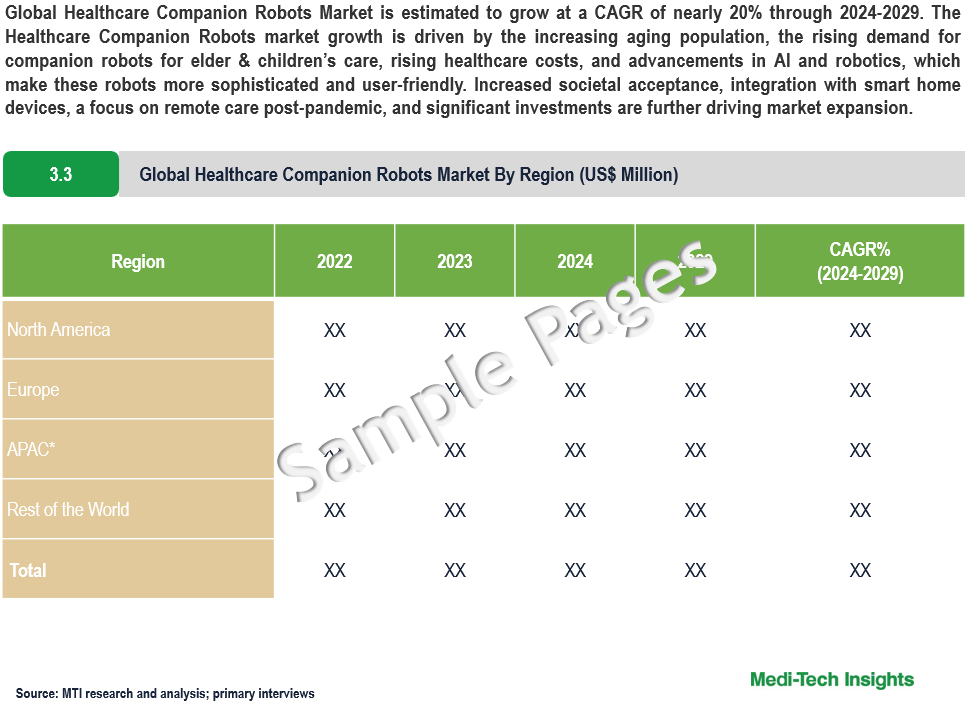
Global Healthcare Companion Robots Market Size, Growth, Trends, and Demand for Forecast (2024-2029)

Global Healthcare Companion Robots Market is estimated to grow at a CAGR of nearly 20% through 2024-2029. The Healthcare Companion Robots market growth is driven by the increasing aging population, the rising demand for companion robots for elder & children’s care, rising healthcare costs, and advancements in AI and robotics, which make these robots more sophisticated and user-friendly. Increased societal acceptance, integration with smart home devices, a focus on remote care post-pandemic, and significant investments are further driving market expansion. To learn more about the research report, download a sample report.
Companion robots offer companionship and emotional support for children, the elderly, disabled people, and people who live alone or have lost a loved one. They are also used in nursing homes and assisted living facilities for elder care. Over the years, the improvements in sensors, actuators, and AI have allowed people to naturally interact with robots through facial expressions, and verbal, and eye contact. As a result of these improvements, there has been a rise in interest in companion robots.
Growing aging population, the rising cost of elder care, and the shortage of caregivers
The population across the globe is aging and the number of caregivers in relation to the aging population is declining. In Japan, there will be an estimated shortage of 1 million caregivers by 2025. The U.S. is facing a similar problem — as the percentage of people aged 65 or older is expected to rise to roughly 26% by 2050. Moreover, the cost of elder care is also rising. According to Genworth’s Cost of Care Survey, elder care costs in the U.S. are rising. Between 2019 and 2020, the cost of in-home care jumped by about 4.4%; assisted living costs surged by 6.2%; and nursing home costs increased by 3%. The use of robots instead could help reduce this cost. For instance, a monthly service contract for Stevie (a robot developed by Trinity College, Dublin) would likely run between 50-60% of the cost of hiring a human to do the same tasks, as per their claim.
“The growing disparity between healthcare workforce and aging population is a concern in many countries and we believe companion robots have a great role to play in bridging this gap” – CEO, Leading Medical Robots Company
Healthcare Companion robots demand surged during the COVID-19 pandemic
The COVID-19 pandemic catalyzed a surge in demand for healthcare companion robots as healthcare systems worldwide sought alternative methods to provide care amidst social distancing measures. These robots, offering assistance and companionship without physical contact, addressed the increased isolation and loneliness experienced by patients, particularly the elderly and those in long-term care facilities. Equipped with telepresence and remote monitoring capabilities, they enabled remote patient monitoring and communication, supporting healthcare providers in delivering care while minimizing exposure risks. Additionally, companion robots relieved some of the burden on overstretched healthcare workers by assisting with tasks and improving efficiency.
According to the International Federation of Robotics (IFR), demand for social robots increased, with such units deployed in nursing homes, for example, to allow residents to keep in touch with family members when social distancing. Companion robot sales of the company Sharp increased by 30% during the September quarter of 2020 compared to the same period last year. Further, companies also launched new robots to cater to COVID-19-infected/isolated people. Hanson Robotics, one of the key players in the companion robots market, launched a robot called Grace in June 2021–designed to interact with the elderly and those isolated by the COVID-19 pandemic. This pandemic-driven adoption underscored the transformative potential of companion robots in healthcare delivery, paving the way for their continued integration into future healthcare practices
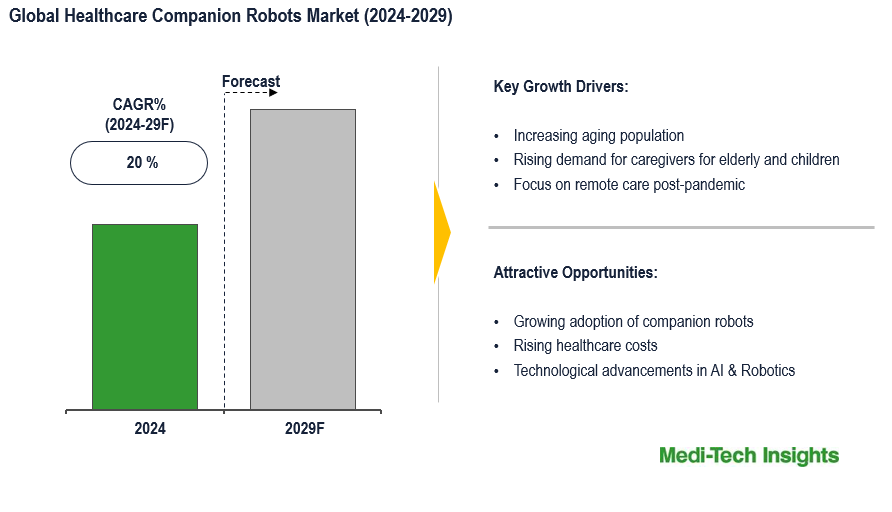
To learn more about this report, download the PDF brochure
Revolutionizing Healthcare: Emerging Trends in Companion Robots
The landscape of companion healthcare robots is undergoing a profound transformation, characterized by advancements in personalization, emotional intelligence, and mobility. These robots are evolving to cater to individual user needs through sophisticated AI algorithms that facilitate adaptive behaviors. By integrating emotional intelligence, they can now empathetically understand and respond to human emotions, while enhanced mobility capabilities enable support in diverse environments. Furthermore, integration with smart home devices and multimodal interfaces enhances functionality and connectivity, catering to a range of user preferences. The incorporation of telepresence features facilitates remote monitoring and virtual consultations, overcoming geographical barriers to access care. Amidst these advancements, ethical considerations surrounding transparency, consent, and data security remain paramount for upholding user trust and confidentiality.
The increasing life expectancy and aging population, both in developed and emerging markets, are driving the adoption of companion robots. Recognizing this growth potential, companies are launching new products tailored to these markets. For instance, in March 2022, Intuition Robotics announced the commercial launch of its digital care companion, ElliQ in South Florida (U.S.). It is a proactive and empathetic care companion robot used by older people for health and wellness support. Further, Emotix has developed a companion robot (Miko) targeted towards children of young parents in India and already started retailing through its channel partners and currently retails across more than 100 offline stores in India. It is also widely available in the e-commerce marketplace like Amazon and Flipkart.
Product Segment Outlook
The global healthcare companion robots market is segmented into two main types: animal-like and humanoid robots. Animal-like robots, such as the popular Paro, are designed to mimic the appearance and behaviour of pets, providing emotional support and companionship primarily to elderly patients and individuals with mental health conditions. These robots are particularly effective in therapeutic settings, where their soothing presence can reduce stress and anxiety. On the other hand, humanoid robots, exemplified by models like ElliQ, are designed to interact more dynamically with users, offering a wide range of functionalities including medication reminders, telepresence, and cognitive exercises. Humanoid robots are gaining traction in both home care and institutional settings due to their versatile applications and advanced AI capabilities. Both segments are experiencing significant growth, driven by increasing demand for innovative solutions to support the aging population and enhance the quality of healthcare delivery globally.
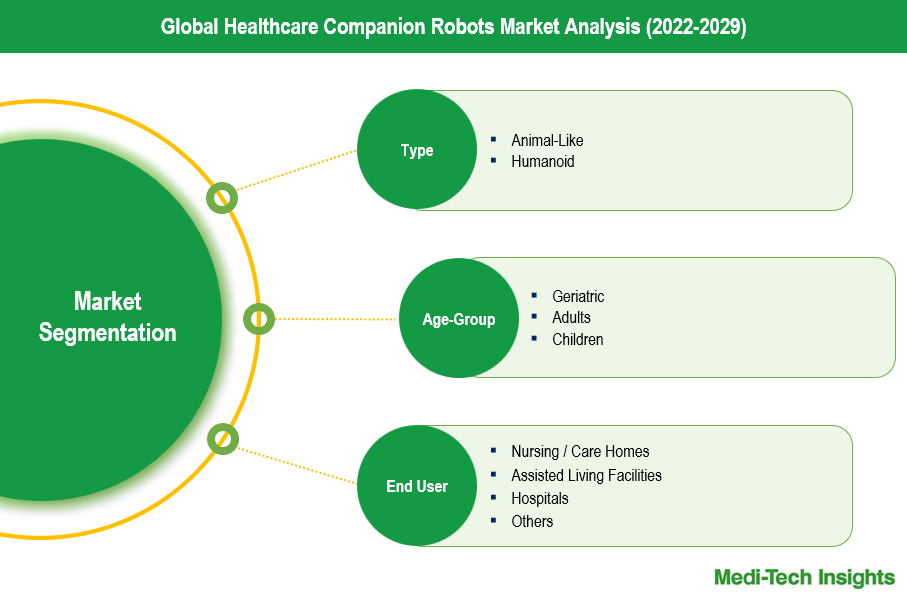
To learn more about this report, download the PDF brochure
Application Outlook
The global healthcare companion robots market is segmented by age group into geriatric, adult, and children categories. The geriatric segment holds the largest market share, driven by the growing elderly population and the rising need for assistance with daily activities, emotional support, and healthcare management. Companion robots for this age group, such as ElliQ, focus on promoting independence and reducing loneliness among seniors. The adult segment, though smaller, is expanding as well, particularly in applications for individuals with chronic illnesses or disabilities who require ongoing monitoring and support. Robots for adults often include features like health tracking, medication reminders, and telehealth capabilities. Meanwhile, the children's segment is growing rapidly, fueled by increasing demand for educational and therapeutic robots like Miko, which help in cognitive development and provide companionship to young users. Each of these segments is experiencing growth due to the diverse and evolving needs of different age groups, enhancing the overall adoption of healthcare companion robots worldwide.
Regional Adoption: Healthcare Companion Robots Market
Comprehensive regional assessment of the global healthcare companion robots market covering the U.S., Europe, Asia-Pacific, and RoW suggests that the U.S. is currently the largest market for healthcare companion robots, followed by Europe, APAC, and RoW. The key reasons for the large share of the U.S. market are the high adoption/demand for companion robots, the growing aging population, the greater purchasing power of the U.S. population, and a large number of hospitals/home-care facilities using companion robots.
Competitive Landscape Analysis: Healthcare Companion Robots Market
Some of the key and established players operating in the global healthcare companion robots market are Blue Frog Robotics, ASUS Zenbo, Intuition Robotics, No Isolation, Luvozo, Honda Robotics, Hanson Robotics, Ubtech, Emotix, Jibo, and Aeolus Robotics among others
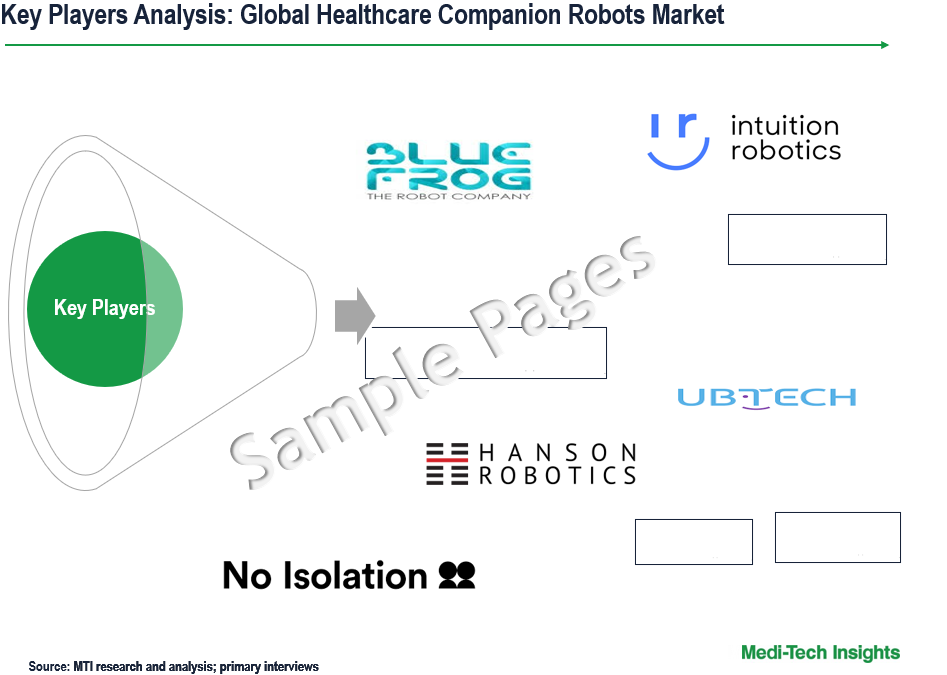
Get a sample report for competitive landscape analysis
Organic and Inorganic Growth Strategies Adopted by Players to Establish Their Foothold in the Market
Players operating in this market are adopting both organic and inorganic growth strategies such as collaborations, acquisitions, and new product launches to garner market share. For instance,
- In September 2023, UBTECH Robotics announced a strategic partnership with the University of Hong Kong to collaborate on research and testing of human-like visual perception algorithms and technology for service robots, aiming to enhance their practical application and precision in the robotics industry
- In August 2023, Intuition Robotics announced securing $25 million in funding, led by Woven Capital and including several other investors, to meet the growing demand for its AI care companion ElliQ, integrate further into the healthcare system, and improve connectivity and access to services for aging populations
- In March 2021, Immervision Inc. announced a partnership with Hanson Robotics Limited, creators of Sophia the Robot, to collaborate on advancing machine perception and human-like vision in JOYCE, the world's first humanoid robot designed to unite the computer vision community
The global healthcare companion market is a growing market that is expected to gain further momentum in the coming years due to technological advancements, new product launches, and aggressive organic and inorganic growth strategies followed by the players.
| Report Scope | Details |
| Base Year Considered | 2023 |
| Historical Data | 2022 - 2023 |
| Forecast Period | 2024 - 2029 |
| CAGR (2024 - 2029) | 20% |
| Segment Scope | Product, Application, End User |
| Regional Scope |
|
| Key Companies Mapped | Blue Frog Robotics, ASUS Zenbo, Intuition Robotics, No Isolation, Luvozo, Honda Robotics, Hanson Robotics, Ubtech, Emotix, Jibo, and Aeolus Robotics among others |
| Report Highlights | Market Size & Forecast, Growth Drivers & Restraints, Trends, Competitive Analysis |
Key Strategic Questions Addressed
-
What is the market size & forecast for the Global Healthcare Companion Robots Market?
-
What are the historical, present, and forecasted market shares and growth rates of various segments and sub-segments of the Global Healthcare Companion Robots Market?
-
How has COVID-19 impacted the Global Healthcare Companion Robots Market?
-
What are the major growth drivers, restraints/challenges impacting the market?
-
What are the opportunities prevailing in the market?
-
What is the investment landscape?
-
Which region has the highest share in the global market? Which region is expected to witness the highest growth rate in the next 5 years?
-
Who are the major players operating in the market? What is the competitive positioning of key players?
-
Who are the new players entering the market?
-
What are the key strategies adopted by players?
- Research Methodology
- Secondary Research
- Primary Research
- Market Estimation
- Market Forecasting
- Executive Summary
- Market Overview
- Market Dynamics
- Drivers
- Restraints
- Key Market Trends
- Market Dynamics
-
- Industry Speaks
- Key Revenue Pockets
- Global Healthcare Companion Robots Market - Size & Forecast (2021-2028), By Type
- Animal-Like
- Humanoid
- Global Healthcare Companion Robots Market - Size & Forecast (2021-2028), By Age-Group
- Geriatric
- Adults
- Children
- Global Healthcare Companion Robots Market - Size & Forecast (2021-2028), By End User
- Nursing / Care Homes
- Assisted Living Facilities
- Hospitals
- Universities
- Others
- Global Healthcare Companion Robots Market - Size & Forecast (2021-2028), By Region
- North America (U.S. & Canada)
- Europe (UK, Germany, France, Italy, Spain, Rest of Europe)
- Asia Pacific (China, India, Japan, Rest of Asia Pacific)
- Rest of the World (Latin America, Middle East & Africa)
- Competitive Landscape
- Key Players and their Competitive Positioning
- Competitive Positioning of Key Players (2022)
- Offerings Assessment, By Player
- Key Strategies Assessment, By Player (2021-2023)
- New Product & Service Launches
- Partnerships, Agreements, & Collaborations
- Mergers & Acquisitions
- Geographic Expansion
- Key Players and their Competitive Positioning
- Key Companies Scanned (Indicative List)
- Blue Frog Robotics
- ASUS Zenbo
- Intuition Robotics
- No Isolation
- Luvozo
- Honda Robotics
- Paro (AIST)
- Hanson Robotics
- Ubtech
- Emotix
- Jibo
- Aeolus Robotics
- Other Prominent Players
The study has been compiled based on extensive primary and secondary research.
Secondary Research (Indicative List)

Primary Research
To validate research findings (market size & forecasts, market segmentation, market dynamics, competitive landscape, key industry trends, etc.), extensive primary interviews were conducted with both supply and demand-side stakeholders.
Supply Side Stakeholders:
- Senior Management Level: CEOs, Presidents, Vice-Presidents, Directors, Chief Technology Officers, Chief Commercial Officers
- Mid-Management Level: Product Managers, Sales Managers, Brand Managers, Business Development Managers, Consultants
Demand Side Stakeholders:
- Stakeholders in Hospitals Pharmacies, Clinic Pharmacies, Mail Order Pharmacies, Retail Pharmacies, Inpatient Pharmacies, Outpatient Pharmacies, Pharmacy Benefit Management and Other End Users
Breakdown of Primary Interviews
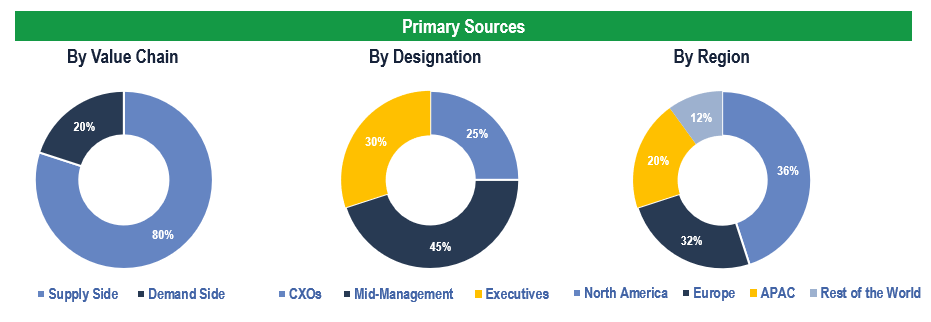
Market Size Estimation
Both ‘Top-Down and Bottom-Up Approaches’ were used to derive market size estimates and forecasts.
Data Triangulation
Research findings derived through secondary sources & internal analysis were validated with Primary Interviews, Internal Knowledge Repository, and Company Sales Data.

